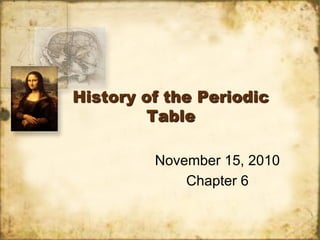Report
Share
Download to read offline

Recommended
Recommended
More Related Content
What's hot
What's hot (20)
Döbereiner and Newland’s classification of elements

Döbereiner and Newland’s classification of elements
Similar to History of the Periodic Table.pdf
Similar to History of the Periodic Table.pdf (20)
Recently uploaded
Bioenergetics is an important domain in biology. This presentation has explored ATP production and its optimum utilization in biological systems along with certain theories and experiments to give a bird's eye view of this important issue.Energy is the beat of life irrespective of the domains. ATP- the energy curre...

Energy is the beat of life irrespective of the domains. ATP- the energy curre...Nistarini College, Purulia (W.B) India
Antibiotics are medicines that fight infections caused by bacteria in humans and animals by either killing the bacteria or making it difficult for the bacteria to grow and multiply. Bacteria are germsABHISHEK ANTIBIOTICS PPT MICROBIOLOGY // USES OF ANTIOBIOTICS TYPES OF ANTIB...

ABHISHEK ANTIBIOTICS PPT MICROBIOLOGY // USES OF ANTIOBIOTICS TYPES OF ANTIB...ABHISHEK SONI NIMT INSTITUTE OF MEDICAL AND PARAMEDCIAL SCIENCES , GOVT PG COLLEGE NOIDA
Recently uploaded (20)
Molecular phylogeny, molecular clock hypothesis, molecular evolution, kimuras...

Molecular phylogeny, molecular clock hypothesis, molecular evolution, kimuras...
Porella : features, morphology, anatomy, reproduction etc.

Porella : features, morphology, anatomy, reproduction etc.
Major groups of bacteria: Spirochetes, Chlamydia, Rickettsia, nanobes, mycopl...

Major groups of bacteria: Spirochetes, Chlamydia, Rickettsia, nanobes, mycopl...
TransientOffsetin14CAftertheCarringtonEventRecordedbyPolarTreeRings

TransientOffsetin14CAftertheCarringtonEventRecordedbyPolarTreeRings
Energy is the beat of life irrespective of the domains. ATP- the energy curre...

Energy is the beat of life irrespective of the domains. ATP- the energy curre...
ABHISHEK ANTIBIOTICS PPT MICROBIOLOGY // USES OF ANTIOBIOTICS TYPES OF ANTIB...

ABHISHEK ANTIBIOTICS PPT MICROBIOLOGY // USES OF ANTIOBIOTICS TYPES OF ANTIB...
POGONATUM : morphology, anatomy, reproduction etc.

POGONATUM : morphology, anatomy, reproduction etc.
development of diagnostic enzyme assay to detect leuser virus

development of diagnostic enzyme assay to detect leuser virus
Site specific recombination and transposition.........pdf

Site specific recombination and transposition.........pdf
Selaginella: features, morphology ,anatomy and reproduction.

Selaginella: features, morphology ,anatomy and reproduction.
COMPOSTING : types of compost, merits and demerits

COMPOSTING : types of compost, merits and demerits
Fourth quarter science 9-Kinetic-and-Potential-Energy.pptx

Fourth quarter science 9-Kinetic-and-Potential-Energy.pptx
History of the Periodic Table.pdf
- 1. History of the Periodic Table November 15, 2010 Chapter 6
- 2. History of the Periodic Table • Aristotle ~330 B.C. • Four element theory: – Earth, Fire, Water, Air
- 3. History of the Periodic Table • Antoine Lavoisier ~1770-1789 • Wrote the first list of elements containing 33 elements • Distinguished between metals and non-metals
- 4. History of the Periodic Table • Jons Jakob Berzelius~ 1828 • Developed a table of atomic weights • Introduced letters to symbolize elements
- 5. History of the Periodic Table • Johann Döbereiner ~ 1829 • Developed 'triads', groups of 3 elements with similar properties – Li, Na & K – Ca, Sr & Ba – Cl, Br & I
- 6. History of the Periodic Table • John Newlands ~1864 • The known elements (>60) were arranged in order of atomic weights • Observed similarities between the first and ninth elements, the second and tenth elements etc • He proposed the 'Law of Octaves'
- 7. History of the Periodic Table • Lothar Meyer ~1869 • Compiled a Periodic Table of 56 elements based on the periodicity of properties such as molar volume when arranged in order of atomic weight
- 8. History of the Periodic Table • Dmitri Mendeleev ~ 1869 • Produced a table based on atomic weights but arranged 'periodically' with elements with similar properties under each other • Gaps were left for elements that were unknown at that time and their properties predicted (the elements were gallium, scandium and germanium) • The order of elements was re-arranged if their properties dictated it
- 9. History of the Periodic Table • William Ramsay ~1894 • Discovered the Noble Gases
- 10. History of the Periodic Table • Henry Moseley ~1913 • Determined the atomic number of each of the elements • He modified the 'Periodic Law' to read that the properties of the elements vary periodically with their atomic numbers • 1914:Predicted that there were 3 unknown elements between aluminum and gold • Concluded there were only 92 elements up to and including uranium
- 11. History of the Periodic Table • Glenn Seaborg ~1940 • Synthesized transuranic elements – The elements after uranium #92 in the periodic table – Also part of the Actinides